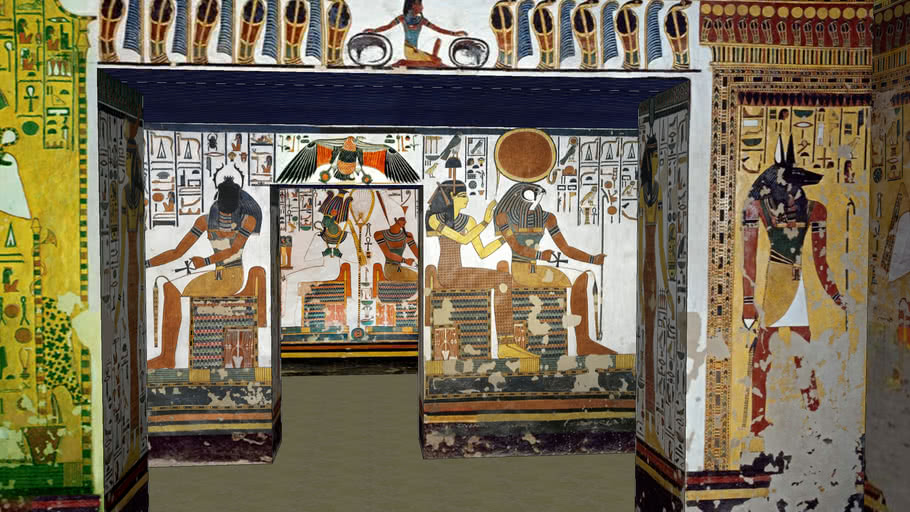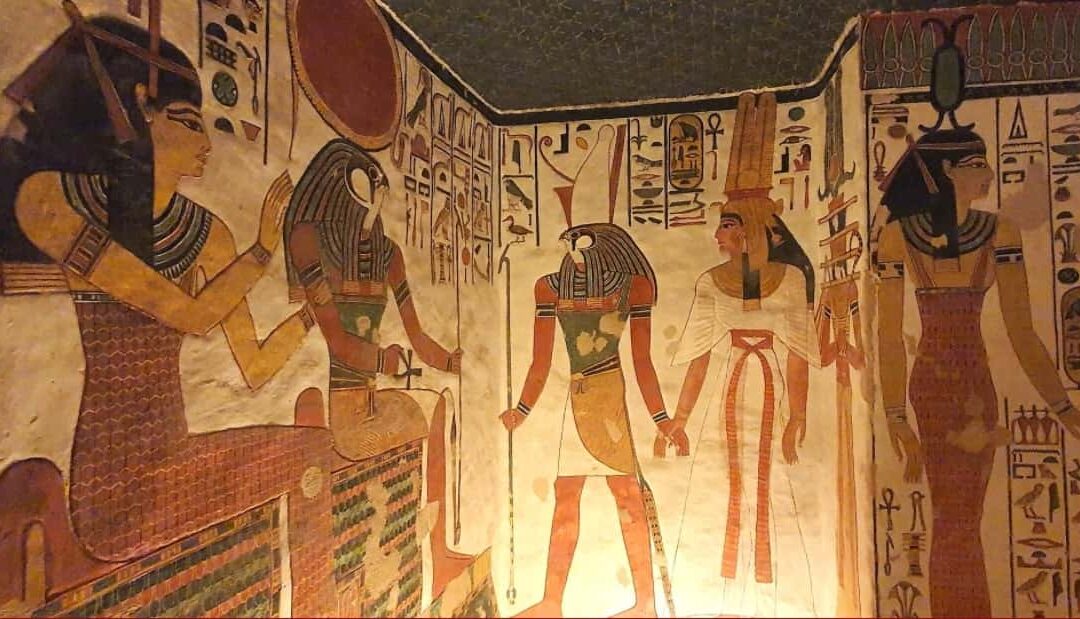Witness the Glory: Inside the Tomb of Nefertari

Discovery and History of the Tomb of Nefertari
Discovery of the Tomb of Nefertari in the Valley of the Queens
In 1904, the Italian Egyptologist Ernesto Schiaparelli discovered the tomb of Queen Nefertari in the Valley of the Queens near Luxor, Egypt. The tomb was found in a remarkable state of preservation, with intricate paintings and hieroglyphics adorning the walls. It was a groundbreaking moment in the history of Egyptology, as it showcased the artistry and craftsmanship of the New Kingdom period.
Historical significance and importance of Queen Nefertari's tomb
Queen Nefertari's tomb is considered one of ancient Egypt's most beautiful and well-preserved tombs. The exquisite artwork and inscriptions within the tomb provide insights into the religious beliefs and practices of the time. The tomb is dedicated to Queen Nefertari's afterlife, emphasizing her importance in Egyptian society. It is also a testament to the wealth and power of the pharaohs during the 19th Dynasty.
The discovery of Queen Nefertari's tomb shed light on the role of royal women in ancient Egypt and underscored the importance of their burial practices. The tomb's intricate decorations and depictions of rituals offer a glimpse into the queen's journey to the afterlife. It remains a significant archaeological find, attracting scholars and visitors from around the world interested in Queen Nefertari's legacy and the artistic achievements of the ancient Egyptians.

Architectural and Artistic Marvels of the Tomb
Design and layout of the Tomb of Nefertari
When you step into the Tomb of Queen Nefertari, you are immediately struck by the grandeur of its design and layout. The tomb features long corridors, multiple chambers, and intricate passageways that lead deeper into the burial site. The architectural precision and symmetry of the tomb reflect the ancient Egyptians' beliefs in order and harmony in the afterlife.
Frescoes and artwork depicting Nefertari's journey to the afterlife
As you admire the frescoes and artwork adorning the walls of Queen Nefertari's tomb, you are transported back in time to the New Kingdom period. The vibrant colours, detailed illustrations, and captivating scenes depict various stages of the queen's journey to the afterlife. From the rituals and offerings to the mythological creatures and deities, each painting tells a story of reverence and spiritual significance.
Conservation Efforts and Challenges
Challenges faced in preserving the Tomb of Nefertari
Preserving the Tomb of Queen Nefertari presents unique challenges due to the delicate nature of the ancient structure and the artworks within. Constant exposure to visitors, humidity, and environmental factors threaten the tomb's integrity. Additionally, the fragility of the painted surfaces requires specialized care to prevent deterioration over time.
Methods and techniques used in the conservation of the tomb
To address these challenges, conservation experts employ meticulous techniques to ensure the longevity of the Tomb of Nefertari. Advanced monitoring systems help regulate temperature and humidity levels within the tomb to create a stable environment. Specialized cleaning methods remove debris and pollutants without damaging the delicate frescoes.
Furthermore, ongoing research and restoration efforts aim to protect and preserve this extraordinary archaeological site for future generations to appreciate.

Symbolism and Inscriptions in the Tomb
Symbolism behind the scenes and inscriptions in Nefertari's tomb
As you explore the Tomb of Nefertari, you will encounter a wealth of symbolism that provides insight into ancient Egyptian beliefs and customs. The scenes depicted on the walls offer a glimpse into the afterlife journey of Queen Nefertari and the rituals associated with death and rebirth.
Symbolic elements such as the goddess Isis, symbolic offerings, and the depiction of the Pharaoh interacting with deities showcase the Egyptians' beliefs in the divine and the afterlife.
Meaning and significance of the hieroglyphics and paintings
The tomb's hieroglyphic inscriptions and intricate paintings convey a deeper meaning beyond their artistic beauty. The hieroglyphics serve as a form of communication with the gods, ensuring Nefertari's safe passage into the afterlife. The vibrant paintings, depicting scenes of daily life, deities, and religious ceremonies, emphasize the importance of rituals and offerings in ensuring the queen's eternal existence in the afterlife. Each symbol and inscription carries profound significance, shedding light on ancient Egypt's religious and spiritual beliefs.

Tourist Visitation and Restrictions
Visitor information and restrictions for the Tomb of Nefertari
When you visit the Tomb of Nefertari, it is essential to abide by the regulations set in place to preserve this ancient site. As a tourist, you will be able to witness the rich symbolism and inscriptions that adorn the tomb walls, providing a glimpse into the beliefs of the ancient Egyptians.
However, to ensure the protection of these precious artefacts, there are restrictions in place regarding photography, touching the walls, and the number of visitors allowed inside at a time. By following these guidelines, you contribute to the ongoing preservation efforts of this historical treasure.
Impact of tourism on the preservation of the tomb
As a popular tourist destination, the Tomb of Nefertari receives significant visitors each year. While tourism allows individuals worldwide to marvel at the beauty of this ancient site, it also raises concerns about preservation. The influx of visitors can result in wear and tear on the delicate artwork and structures within the tomb.
To mitigate these impacts, conservation efforts are continuously underway to ensure that future generations can continue to appreciate the magnificence of Queen Nefertari's final resting place.

Comparison with Other Ancient Egyptian Tombs
Contrast with other tombs in the Valley of the Queens
When comparing the Tomb of Nefertari with other tombs in the Valley of the Queens, a stark contrast can be observed regarding preservation efforts and restrictions. While the Tomb of Nefertari imposes strict limitations on visitor behaviour to protect its delicate artefacts, some other tombs may have more lenient rules, leading to increased damage over time. The significance of Queen Nefertari's tomb is underscored by the meticulous care taken to ensure its longevity.
Unique features that set the Tomb of Nefertari apart
The Tomb of Nefertari stands out from other ancient Egyptian tombs due to its elaborate and intricate artwork adoring the walls. The detailed depictions of Egyptian mythology and scenes from the afterlife make this tomb a treasure trove of historical and cultural significance.
Additionally, the restrictions placed on photography and visitor numbers contribute to the uniqueness of the experience, allowing for a more intimate and immersive exploration of Queen Nefertari's final resting place.

The Curse of the Tomb
Myth or reality: The curse associated with Nefertari's tomb
When considering the Tomb of Nefertari, the topic of curses often arises. Many believe that a curse is associated with the tomb due to the misfortunes that have befallen some individuals who have entered it. Whether this curse is rooted in reality or merely a product of superstition is debatable. However, the tomb's mystery and caution add to its allure and mystique.
Famous incidents and superstitions related to the curse
Over the years, several incidents have fueled the belief in the curse of Nefertari's tomb. Stories of individuals experiencing sudden illness, financial ruin, or even untimely death after visiting the tomb have contributed to the superstitions surrounding it.
While these accounts may be dismissed as mere coincidences, they have solidified the tomb's reputation as a place not to be taken lightly. Visitors are often warned to respect the site's sanctity and proceed with caution.

Legacy and Cultural Significance
Legacy of Queen Nefertari and her tomb in Egyptian history
Researchers and archaeologists have extensively studied the Tomb of Nefertari, delving into its history, construction, and significance. Academic papers and publications have explored the tomb's architectural marvels and intricate details, shedding light on Nefertari's role and stature in ancient Egyptian society. These scholarly works provide valuable insights into the cultural and religious practices of the time, offering a nuanced perspective on the enigmatic queen and her final resting place.
Depiction of Nefertari's tomb in popular culture and media
Nefertari's tomb has captured the imagination of artists, writers, and filmmakers, inspiring numerous creative works across various mediums. From novels to documentaries, the allure of the tomb's supposed curse and its historical significance has been a recurring theme in popular culture. Fictionalized accounts often embellish the mysterious elements surrounding the tomb, amplifying its reputation as a place of both wonder and danger in the eyes of the public.
